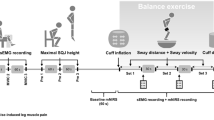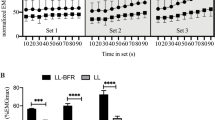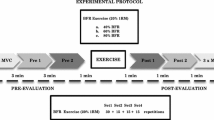Abstract
Purpose
Ammonia is used as a stimulant in strength based sports to increase arousal and offset fatigue however little is known about its physiological and performance effects. The purpose of this study was twofold (1) establish the physiological response to acute ammonia inhalation (2) determine whether the timing of the physiological response corresponds with a performance enhancement, if any.
Methods
Fifteen healthy males completed two trials. Trial one investigated the beat-to-beat middle cerebral artery blood flow velocity (MCAv), heart rate (HR) and mean arterial pressure (MAP) response to ammonia inhalation. During trial two, participants performed a maximal single mid-thigh pull (MTP) at various time points following ammonia inhalation in a randomised order: MTPs were conducted immediately, 15, 30 and 60 s following ammonia inhalation. A MTP with no ammonia inhalation served as the control. During this trial maximal MTP force, rate of force development (RFD) and electromyography (EMG) activity were recorded.
Results
MCAvmean increased and peaked on average by 6 cm s−1 (P < 0.001), 9.4 ± 5.5 s following ammonia inhalation. Similarly, HR was increased by 6 ± 11 beats per minute 15 s following ammonia inhalation (P < 0.001). MAP remained unchanged following inhalation (P = 0.51). The use and timing of ammonia inhalation had no effect on maximal force, RFD or EMG (all P > 0.2) compared to control.
Conclusions
MCAv was elevated despite no increase in MAP occurring; this is indicative of a cerebrovascular vasodilation. Despite the marked cerebrovascular and cardiovascular response to ammonia inhalation no ergogenic effect was observed during the MTP, irrespective of the timing of administration.


Similar content being viewed by others
Abbreviations
- CVCi:
-
Cerebral vascular conductance index
- EMG:
-
Electromyography
- IPF:
-
International Powerlifting Federation
- Map:
-
Mean arterial pressure
- MCAv:
-
Middle cerebral artery blood flow velocity
- MTP:
-
Mid-thigh pull
- MVIC:
-
Maximum voluntary isometric contraction
- nEMG:
-
Normalised EMG
- P ETCo2 :
-
Partial pressure of end tidal Co2
- pRFD:
-
Peak rate of force development
- \( \dot{Q} \) :
-
Cardiac output
- RFD:
-
Rate of force development
- RM:
-
Repetition maximum
References
Aaslid R, Markwalder TM, Nornes H (1982) Noninvasive transcranial Doppler ultrasound recording of flow velocity in basal cerebral arteries. J Neurosurg 57:769–774
Aaslid R, Lindegaard KF, Sorteberg W, Nornes H (1989) Cerebral autoregulation dynamics in humans. Stroke 20:45–52
Compton D, Hill P, Sinclair J (1973) Weight-lifters’ blackout. Lancet 302:1234–1237
Coverdale NS, Gati JS, Opalevych O, Perrotta A, Shoemaker JK (2014) Cerebral blood flow velocity underestimates cerebral blood flow during modest hypercapnia and hypocapnia. J Appl Physiol 117:1090–1096
Del Coso J, Muñoz G, Muñoz-Guerra J (2011) Prevalence of caffeine use in elite athletes following its removal from the World Anti-Doping Agency list of banned substances. Appl Physiol Nutr Metab 36:555–561
Dynarex Corporation (2012) Ammonia inhalation solution: material safety data sheet. Dynarex Corporation. http://www.dynarex.com/MSDS/MSDS_Ampules-Sting_Pads_(1401).pdf. Accessed 25 Apr 2015
Ebben W, Feldmann C, Dayne A, Mitsche D, Alexander P, Knetzger K (2009) Muscle activation during lower body resistance training. Int J Sports Med 30:1–8
Escamilla RF, Francisco AC, Kayes AV, Speer KP, Moorman C 3rd (2002) An electromyographic analysis of sumo and conventional style deadlifts. Med Sci Sports Exerc 34:682–688
Giller CA, Bowman G, Dyer H, Mootz L, Krippner W (1993) Cerebral arterial diameters during changes in blood pressure and carbon dioxide during craniotomy. Neurosurgery 32:737–742
Gonzalez AM, Walsh AL, Ratamess NA, Kang J, Hoffman JR (2011) Effect of a pre-workout energy supplement on acute multi-joint resistance exercise. J Sports Sci Med 10:261
Haff GG, Ruben RP, Lider J, Twine C, Cormie P (2015) A comparison of methods for determining the rate of force development during isometric mid-thigh clean pulls. J Strength Cond Res 29:386–395
Hermens HJ, Freriks B, Disselhorst-Klug C, Rau G (2000) Development of recommendations for SEMG sensors and sensor placement procedures. J Electromyogr Kinesiol 10:361–374
Ide K, Eliasziw M, Poulin MJ (2003) Relationship between middle cerebral artery blood velocity and end-tidal PCO2 in the hypocapnic-hypercapnic range in humans. J Appl Physiol 95:129–137
International Powerlifting Federation (2012) Technical rules book. International Powerlifting Federation, Luxembourg
International Weightlifting Federation (2015) Technical and competition rules and regulations. The International Weightlifting Federation, Budapest, Hungary
Julu P, Cooper V, Hansen S, Hainsworth R (2003) Cardiovascular regulation in the period preceding vasovagal syncope in conscious humans. J Physiol 549:299–311
Kawamori N, Rossi SJ, Justice BD, Haff EE, Pistilli EE, O’Bryant HS, Stone MH, Haff GG (2006) Peak force and rate of force development during isometric and dynamic mid-thigh clean pulls performed at various intensities. J Strength Cond Res 20:483–491
Keogh JWL, Hume PA, Pearson SN, Mellow PJ (2009) Can absolute and proportional anthropometric characteristics distinguish stronger and weaker powerlifters? J Strength Cond Res 23:2256–2265
Konrad P (2012) The ABC of EMG: a practical introduction to kinesiological electromyography. Noraxon USA Inc., Scottsdale, Arizona
Maughan RJ, Depiesse F, Geyer H (2007) The use of dietary supplements by athletes. J Sports Sci 25:S103–S113
McCrory P (2006) Smelling salts. Br J Sports Med 40:659
Ogoh S, Brothers RM, Barnes Q, Eubank WL, Hawkins MN, Purkayastha S (2005) The effect of changes in cardiac output on middle cerebral artery mean blood velocity at rest and during exercise. J Physiol 569:697–704
Ott P, Vilstrup H (2014) Cerebral effects of ammonia in liver disease: current hypotheses. Metab Brain Dis 29:901–911
Perry BG, Schlader ZJ, Barnes MJ, Cochrane DJ, Lucas S, Mündel T (2013) Hemodynamic response to upright resistance exercise: effect of load and repetition. Med Sci Sports Exerc 46:479–487
Prentice C, Stannard SR, Barnes MJ (2013) The effects of binge drinking behaviour on recovery and performance after a rugby match. J Sport Health Sci 17:244–248
Pritchard HJ, Stannard SR, Barnes MJ (2014) Ammonia inhalant and stimulant use among powerlifters: results from an international survey. J Aus Strength Cond 22:52–54
Richmond SR, Potts AC, Sherman JR (2014) The impact of ammonia inhalants on strength performance in resistance trained males. J Exerc Physiol Online 17:60–66
Slater G, Phillips SM (2011) Nutrition guidelines for strength sports: sprinting, weightlifting, throwing events, and bodybuilding. J Sports Sci 29:S67–S77
Sørensen M (2013) Update on cerebral uptake of blood ammonia. Metab Brain Dis 28:155–159
Tod D, Iredale F, Gill N (2003) ‘Psyching-up’ and muscular force production. Sports Med 33:47–58
Tofteng F, Larsen FS (2004) The effect of indomethacin on intracranial pressure, cerebral perfusion and extracellular lactate and glutamate concentrations in patients with fulminant hepatic failure. J Cereb Blood Flow Metab 24:798–804
Valdueza JM, Balzer JO, Villringer A, Vogl TJ, Kutter R, Einh K (1997) Changes in blood flow velocity and diameter of the middle cerebral artery during hyperventilation: assessment with MR and transcranial Doppler sonography. Am J Neuroradiol 18:1929–1934
Vaquero J, Chung C, Blei AT (2004) Cerebral blood flow in acute liver failure: a finding in search of a mechanism. Metab Brain Dis 19:177–194
Velasquez JR (2011) The use of ammonia inhalants among athletes. Strength Cond J 33:33–35
Warren GL, Park ND, Maresca RD, McKibans KI, Millard-Stafford ML (2010) Effect of caffeine ingestion on muscular strength and endurance: a meta-analysis. Med Sci Sports Exerc 42:1375–1387
Widdicombe J, Lee L-Y (2001) Airway reflexes, autonomic function, and cardiovascular responses. Environ Health Perspec 109:579
Willie C, Colino F, Bailey D, Tzeng Y, Binsted G, Jones L, Haykowsky M, Bellapart J, Ogoh S, Smith K (2011) Utility of transcranial Doppler ultrasound for the integrative assessment of cerebrovascular function. J Neurosci Methods 196:221–237
World Anti-Doping Agency (2014) The World Anti-doping code: the 2014 prohibited list. World Anti-Doping Agency. https://wada-main.s3.amazonaws.com/?files/WADA-Revised-2014-Prohibited-List_EN.PDF. Accessed 24 Apr 2015
Zhang R, Zuckerman JH, Giller CA, Levine BD (1998) Transfer function analysis of dynamic cerebral autoregulation in humans. Am J Physiol Heart Circ Physiol 274:233–241
Acknowledgments
The authors would like to thank the participants for their time and effort.
Author information
Authors and Affiliations
Corresponding author
Ethics declarations
Conflict of interest
No conflicts of interest.
Additional information
Communicated by William J. Kraemer.
Rights and permissions
About this article
Cite this article
Perry, B.G., Pritchard, H.J. & Barnes, M.J. Cerebrovascular, cardiovascular and strength responses to acute ammonia inhalation. Eur J Appl Physiol 116, 583–592 (2016). https://doi.org/10.1007/s00421-015-3313-7
Received:
Accepted:
Published:
Issue Date:
DOI: https://doi.org/10.1007/s00421-015-3313-7




